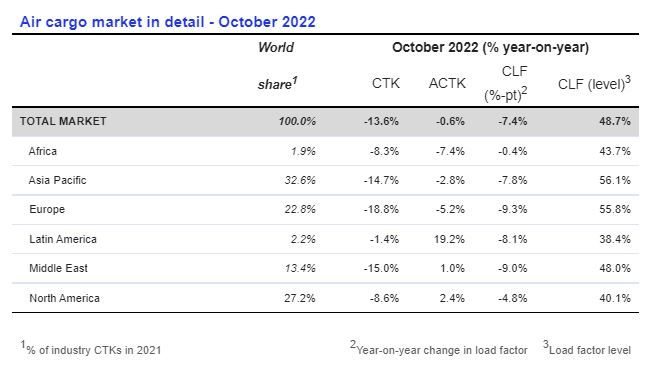The International Air Transport Association's (Iata) latest data for October 2022 global air cargo markets shows that headwinds continue to affect demand.
Global demand, measured in cargo tonne-kilometres (CTKs), fell 13.6% compared to October 2021 (-13.5% for international operations), while capacity was 0.6% below October 2021. This was the first year-on-year contraction since April 2022, however, month-on-month capacity increased by 2.4% in preparation for the year-end peak season. International cargo capacity grew 2.4% compared to October 2021.
Several factors in the operating environment:
• New export orders, a leading indicator of cargo demand, are shrinking in all markets except China and South Korea, which registered slightly higher new export orders in October.
• Latest global goods trade figures showed a 5.6% expansion in September, a positive sign for the global economy. This is expected to primarily benefit maritime cargo, with a slight boost to air cargo as well.
• The US dollar has seen a sharp appreciation, with the overall real effective exchange rate in September 2022 reaching the highest level since 1986. A strong dollar affects air cargo. As many costs are denominated in dollars, the currency’s appreciation adds another layer of cost on top of high inflation and high jet fuel prices.
• The Consumer Price Index increased slightly in G7 countries in October and remains at a decades-high level of 7.8%. Inflation in producer (input) prices reduced by 0.5 percentage points to 13.3% in September.
"Air cargo continues to demonstrate resilience as headwinds persist. Cargo demand in October -- while tracking below the exceptional performance of October 2021-- saw a 3.5% increase in demand compared to September. This indicates that the year-end will still bring a traditional peak-season boost despite economic uncertainties. But as 2022 closes out it appears that the current economic uncertainties will follow into the New Year and need continued close monitoring," says Willie Walsh, Iata’s director general.
October regional performance
Asia-Pacific airlines saw their air cargo volumes decrease by 14.7% in October 2022 compared to the same month in 2021. This was a decline in performance compared to September (-10.7%). Airlines in the region continue to be impacted by the war in Ukraine, and lower levels of trade and manufacturing activity due to Omicron-related restrictions in China. Available capacity in the region decreased by 2.8% compared to 2021.
North American carriers posted an 8.6% decrease in cargo volumes in October 2022 compared to the same month in 2021. This was a decline in performance compared to September (-6.0%). Capacity increased by 2.4% compared to October 2021.
European carriers saw an 18.8% decrease in cargo volumes in October 2022 compared to the same month in 2021. This was the worst performance of all regions and a decline in performance compared to September (-15.6%). This is attributable to the war in Ukraine. High inflation levels, most notably in Türkiye, also affected volumes. Capacity decreased by 5.2% in October 2022 compared to October 2021.
Middle Eastern carriers experienced a 15.0% year-on-year decrease in cargo volumes in October 2022. This was a marginal improvement to the previous month (-15.8%). Stagnant cargo volumes to/from Europe impacted the region’s performance. Capacity increased by 1.0% compared to October 2021.
Latin American carriers reported a decrease in demand of 1.4% in cargo volumes in October 2022 compared to October 2021. This was the most robust performance of all regions, however, it still was a significant decline in performance compared to September (10.8%). This was the first decline in volumes since March 2021. Capacity in October was up 19.2% compared to the same month in 2021.
African airlines saw cargo volumes decrease by 8.3% in October 2022 compared to October 2021. This was a significant decrease in the growth recorded the previous month (0.1%). Capacity was 7.4% below October 2021 levels.
















